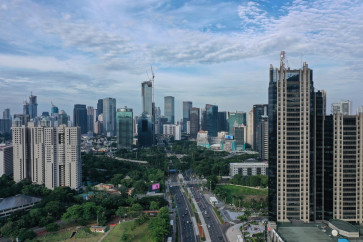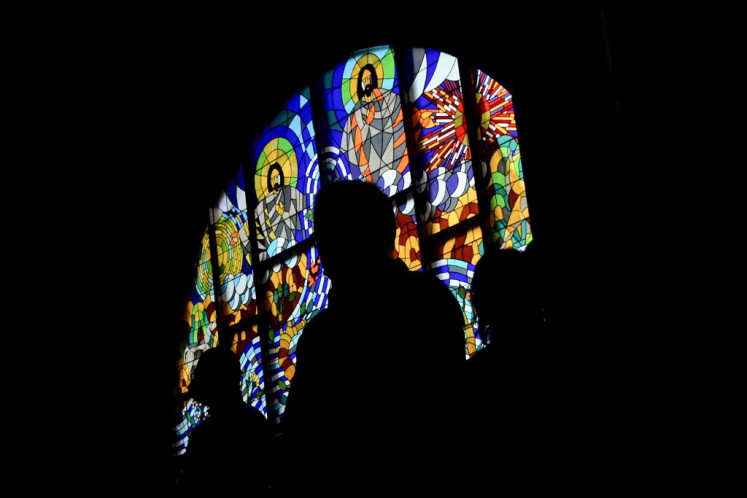Popular Reads
Top Results
Can't find what you're looking for?
View all search resultsPopular Reads
Top Results
Can't find what you're looking for?
View all search resultsLight pollution renders Jakarta's skies starless
Bright lights, big city: Central Jakarta areas including Kemayoran, Menteng, Petamburan and Senen belong to the areas with city and inner city sky, the two highest categories of night sky brightness
Change text size
Gift Premium Articles
to Anyone
B
right lights, big city: Central Jakarta areas including Kemayoran, Menteng, Petamburan and Senen belong to the areas with city and inner city sky, the two highest categories of night sky brightness. The measure is based on the Bortle Dark-Sky Scale, a nine-level numeric that calculates sky quality.(Source: lightpollutionmap.info)
Excessive lighting leaves city residents blind to nature's charms
One early evening as Sesilia Gisela was heading home from her office on Jl. Sudirman to her rented house on Jl. Kebon Kacang, both in Central Jakarta, the 23-year-old who had just moved to Jakarta was shocked as she was blinded by a flash of light.
“The light came from a big LED monitor on the road opposite Sudirman Station. It passed through the window of the Transjakarta bus I was riding,” Gisela, who is originally from Makassar, South Sulawesi, recently told The Jakarta Post. “I’m used to it now, although in the first few days, it was bright enough to blind my eyes,” she said.
Many residents may have experienced similar visual discomfort while driving, walking or just hanging out on an evening in Jakarta, but they might have also become so used to such disrupting flashes that the "bright lights of the big city" have lost their charm.
But as Jakartans face worsening air pollution, many may not realize that the city's excessive lighting is only adding to its pollution problems on its quest toward more urbanization: light pollution.
According to light pollution map Kemayoran, Menteng, Petamburan and Senen in Central Jakarta fall under "city sky" and "inner-city sky", the two highest categories on the nine-level Bortle scale, which measures the brightness of the night sky in a specific location.
Called the Bortle Dark-Sky Scale in the original proposal American astronomer John Bortle developed the scale to help amateur astronomers evaluate the darkness of the sky above a particular observation point in 2001, based on his experience of nearly 50 years.
The Bortle scale classifies the night sky on a descending scale from 1 through 9 (darkest to brightest) according to the naked eye limiting magnitude – that is, the minimum observable brightness of a celestial body. Each class is defined according to strict criteria involving scientific measurements and visible descriptions.

The adjacent areas, which include Kebon Jeruk and Palmerah in West Jakarta, Pasar Minggu and Pancoran in South Jakarta, Duren Sawit and Pulogadung in East Jakarta and Penjaringan and Kepala Gading in North Jakarta all belong to the suburban-urban transition sky category, or class 7.
The cities surrounding Jakarta, including Balaraja, Bekasi, Cobinong, Karawang, Kedungwaringin, Panongan, Parungpanjang, Setu, Sukatani and Tangerang, fall into classes 5-7.
Falling within the 0-18.38 magnitude per square arcsecond range, Central Jakarta —the city's administrative and business center — uses the most excessive lighting.
Ronny Syamara, an astronomer at the Jakarta Planetarium and Observatory in Central Jakarta, complained that the stars had disappeared from the city’s skies, which he said were too bright due to excessive lighting.
“Light pollution happens because of the city’s distribution and overuse of lighting that has brightened the sky to defeat starlight,” he told the Post.
Ronny said that to enjoy gazing at the stars — one of the few celestial bodies that can be seen with the naked eye — the capital's residents now needed specialized equipment like telescopes that gathered electromagnetic radiation to form the images of observed objects.
“Even with the help of instruments, objects categorized as deep-sky or dim objects, aside from planets, moons and bright stars, are hard to observe,” he said.
Ronny added that he was unsure when the light pollution in Jakarta started to grow worse, but that it had certainly increased with population growth and industrial development, which had also boosted the use of lighting.
“Therefore, the amount of energy that is released into the environment has also become excessive, whether it is from garden lights, sidewalk lights, [lighted] billboards, LED monitors or any other source of light that is operated ineffectively,” he said.
Thomas Djamaluddin, head of the National Institute of Aeronautics and Space (LAPAN), said that urban areas with excessive lighting would cause disruptions, not only to astronomical observations but also sleep patterns.
“Light pollution causes a nighttime environment that is similar to the daytime environment, and thus changes people’s sleep patterns, especially for those who are very sensitive to light. It has an effect on people’s health,” Thomas told the Post.
Somnologist Andreas Prasadja confirmed that light pollution could cause delayed sleep phase disorder, as light played an important role in regulating the body’s biological rhythms, or body clock, including sleeping and waking, reported Antara News.
Andreas said that sleep disruption could in turn lead to reduced physical endurance, as well as increased risk for developing heart disease like high blood pressure, heart attack and stroke.
“When somebody’s sleep pattern is interrupted, the person may feel unwell from head to toe,” said the sleep doctor.
In addition, said Andreas, in more complex cases, sleep disruption could lead to metabolic disorders that could cause increased risk of diabetes and obesity, as well as increased risk of breast cancer for women.
“Women who sleep less than seven hours a day may have a 36 percent increase in the risk of cancers,” he said.
The Jakarta planetarium's Ronny said that beyond human impacts, light pollution also had ecological impacts on plants and animals that depended heavily on the revolution from day to night.
“Light affects the [developmental] patterns of plants and animals, since it sustains activities such as reproduction, migration, eating, sleeping and defending themselves from prey,” said Ronny.
For example, he said, amphibians like frogs had nocturnal mating habits, so light pollution could interfere with the animals’ reproductive behavior and lead to a decline in population.
Ronny added that the Jakarta planetarium had recently initiated an annual education program for elementary schools in the city to raise public awareness about light pollution.
“We are targeting 40 elementary schools each year so the children understand about light pollution from an early age. We will teach them against the background of the gradual disruption to watching stars,” he said.
“This is our initial step to mandating Law No. 21/2013 on space, which states that the public is responsible for maintaining order, safety and security of space activities,” he added.
Meanwhile, LAPAN has been running the annual Dark Sky Night campaign every Aug. 6 to commemorate the issuance of the Space Law six years ago.
“What we do during Dark Sky Night is to turn off all [outdoor] lights for just one hour from 8 p.m. to 9 p.m., when dusk has faded, the sun has set and outdoor activities begin to slow down. We then go outside and look at the sky together,” said Thomas.
“So far, the astronomy community has been enthusiastic about the campaign. But we also want to slowly raise public awareness so that more and more people will understand the concept of light pollution,” he said. (syk)










